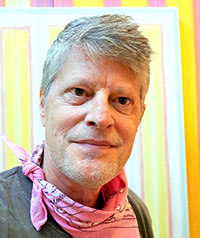 *
*
I was glad to catch up with Somerville-artist Karl Stephan. Stephan is an artist who wears many hats, and I wanted to see what’s brewing under them.
Doug Holder: Tell us about your Somerville experience, as an artist.

Karl Stephan
Karl Stephan: Somerville is a city that cares about and supports art and artists. Before I moved here from Cambridge, I showed work at both Nave Gallery locations. Later I curated a set of shows at Nave. Since moving to town I’ve helped the Arts Council select muralists, the Somerville Museum select curators, been artist of the month at Somerville Media Center and of course shown in Open Studios. This fall I’ll be leading a Virtual Art and Ales session at Aeronaut Brewing. I can’t wait.
DH: You were in the business world for many years. Why the switch?
KS: I studied art in college and learned business out of necessity. I’ve washed dishes, bused tables, delivered furniture and heavy appliances. I worked in a factory for a day. I was a bill collector and back-office worker in a bank. Approaching thirty, I tried my hand at sales. I got good at that and I rode my luck until the stress nearly destroyed my life. Luckily, a good year in 2013 made it possible to get my Masters at Tufts SMFA in 2014.
DH: You teach art at your Cambridge Central Square Studio. Tell me how does a typical class play out?
KS: Whether in my studio or in the Museum of Fine Arts, my core teaching philosophy is the same: art builds community. In the museum I taught observational drawing to teens and adults in the galleries. I now teach similar lessons on Zoom. A typical class starts with a brief talk on an artistic principle, followed by a group exercise exploring museum-quality examples. Then students perform individual choice exercises, challenges, and small group activities. So we practice the principle alone and together, which creates a community bond. Painting students each pursue their own projects and the community forms as they learn by doing with guidance and learn from each other as well. We’re all in it together!
DH: You also work with musician Sarah Bob and her Longy School of Music students. You discuss the intersection of art and music. Are your students surprised that each feed off the other?
KS: Sarah and her “Power of Art” students at Longy are wonderful collaborators. Students may be surprised at first to learn of the connections between art and music, but we discuss the phenomenon of synesthesia, in which one set of senses may literally trigger another. A few students are synesthetic themselves. These are powerful conversations. Countless artists have been inspired by music, and many musicians are also artists.
DH: In some of your own work, from what I have seen, you paint these linear colorful boxes, with equally ornate vertical lines, creating segmented spaces within the box. Can you talk about this?
KS: I intended to strike the viewer in the same way a favorite note or chord in a song strikes a listener. Some pieces of music contain certain passages that thrill or chill. Those involuntary sensations are what I’m hoping to deliver. Pieces are also intended to harmonize together, like voices in a choir. In a sense I’m trying to make music with paint, which sounds a bit like alchemy, and maybe it is. My hope is the work will resonate with anyone who sees it.
DH: Tell me about your work as a curator.
KS: All curators look for art that works well together, but each curator has their own goals. Here again, for me art builds community. To properly serve a community, a curator must be as inclusive as they can. My first Wall to Wall (W2W) show at the Nave Gallery featured community-oriented artists, mostly from the Boston area. These included some of Boston’s best-known street artists, plus teachers, social workers, activists and others. W2W2 was subtitled We Work Together, and featured collaborations between all types of artists, from Appalachian quilters to MIT computer scientists, from as far away as England and Japan. I like to cast a wide curatorial net.
DH: I noticed in your bio that you were a military brat educated by Quakers. Seems oxymoronic, no? Has your Quaker education influenced your work?
KS: I am the antiwar son and grandson of distinguished Naval officers, which is less oxymoronic than “Military Intelligence,” but yes, unusual. I graduated high school just after the Vietnam war ended, so it was my privilege to choose the path I did. I give my family credit for not discouraging me. Quaker education introduced me to a much less hierarchical social system than the one my father or grandfathers knew. This translates well into 21st century art and into art education, which are both engaged in creating space for many who were long excluded. I’m grateful for the experience.
Website: karlstephanstudio.com
Instagram: instagram.com/karlstephanstudio















Karl is a great grad of Guilford College in Greensboro, NC. I am a proud owner of one of his works.